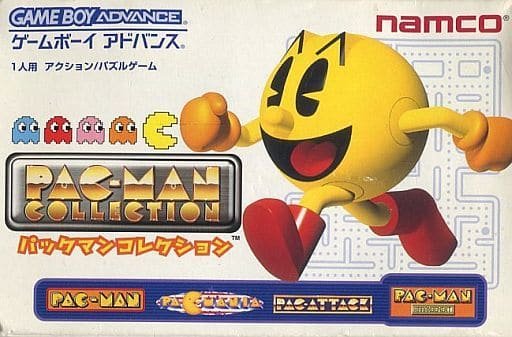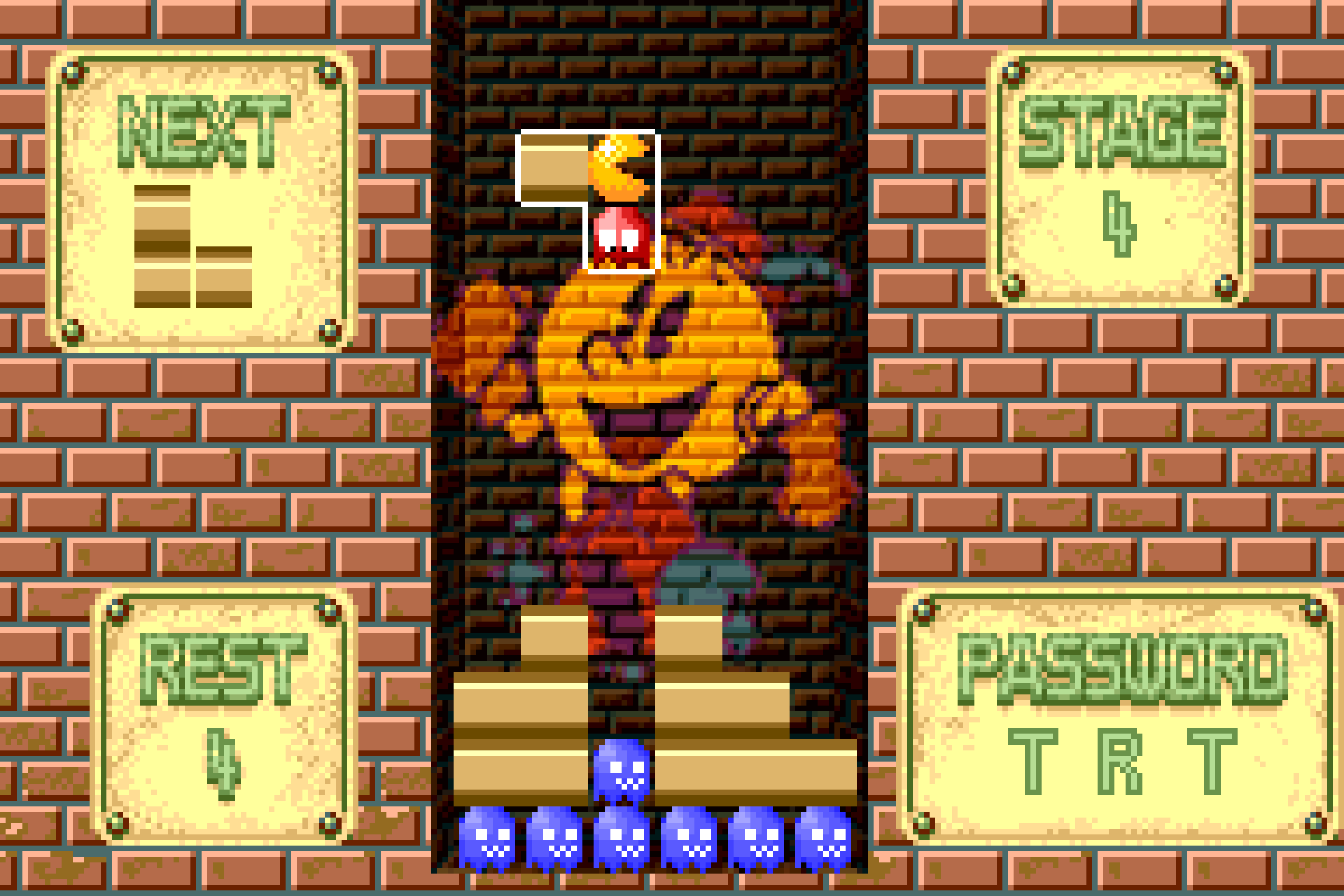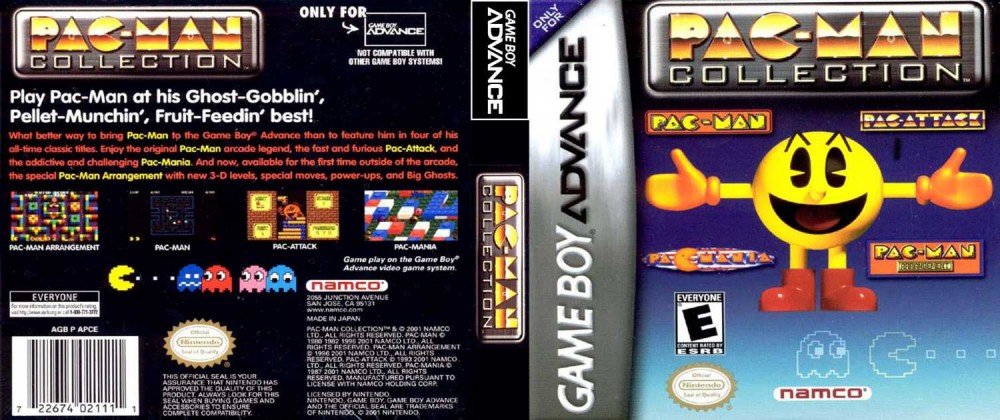Pac-Man Collection review
I love Pac-Man. In all my incoherent raving about video games generally, I may have neglected to point this out. But that’s mostly just because I assume everybody loves Pac-Man, not just me. My fondness for video games' first icon should really go without saying. But just for clarity’s sake, I am definitely a Pac-Man fan.
In fact, when I think back to childhood, I’m pretty sure that a stuffed or beanbag Pac-Man was one of my first plush toys. I distinctly remember having very few stuffed animals—a Baby Kermit, a Pac-Man, a stuffed Raphael (TMNT), and an Ultimate Warrior wrestling buddy, if that counts—and Pac-Man was one of them. I’m not quite old enough to remember seeing the Pac-Man saturday morning cartoon and I’m not sure I even knew there was one. But I was definitely aware of the Pac-Man character, and that he came from an arcade game.
Throughout the 1990’s I got very into video games, but if I’m being honest, Pac-Man wasn’t really a part of that. Even though the original arcade had been a megahit—and even though Ms. Pac-Man, the unofficial spinoff created here in the US, was also a bonafide classic—the character seemed to fade from cultural relevance. The arcade game still held up, of course, but it was an artifact from a bygone era. There simply wasn’t much going on to make you think of Pac-Man.
In fact, the original game became the linguistic shorthand for an outdated conception of what video games actually are. As Tim Rogers painstaking chronicles in his 3-hour ACTION BUTTON review of Pac-Man, the phrase “Video Games have come a long way since Pac-Man” found its way into many, many, many mainstream media discussions of video games. The game was a cultural touchstone, and one that everybody knew was super old.
By 2001, when Nintendo released their Game Boy Advance handheld, it made sense that we would spend our gaming dollars on stuff like Super Mario Advance, Tony Hawk Pro Skater 2, and Dodge Ball Advance. And yeah, I definitely bought those games. Then, standing in a Target that summer, I saw a familiar cartoon face and felt strangely compelled to buy yet another GBA cartridge; this one was called Pac-Man Collection. And you know what? It turned out to be one of my favorite games on the system.
Pac-Man Collection on Game Boy Advance features only four games—Pac-Man, Pac-Mania, Pac-Attack, and Pac-Man Arrangement—which might seem sparse. But don’t worry, what the compilation lacks in quantity, it more than makes up for in quality. Because honestly, these are more-or-less the only Pac-Men you are going to actually want to play. (Assuming that Ms. Pac-Man is not included, as is usually the case. That one’s also pretty good.)
Not only is the game list pretty solid, but this collection has a few quality of life features too. The original Pac-Man, for example, can be played in two different visual presentations. And each game includes a Tips menu with legitimately useful information for how to play. I am fairly certain this was actually the first place I ever saw strategies for how to play the Pac-Man. And those tips really have been super helpful.
Ok, let’s look at each game in the collection individually.
Pac-Man (1980)
The original, and still undefeated, arcade classic, Pac-Man appears in its entirety here, complete and uncut. This game exploded in popularity when it hit arcades and started a national phenomenon, an ailment commonly referred to as “Pac-Man Fever”. I wonder if this game—perhaps with help from sequent character-based titles like Donkey Kong and Qbert—was largely responsible for rehabilitating the public image of video arcades, from hives of scum and delinquency, to a more family-friendly diversion. In any case, of all the quarter-munching hits of arcades past, I’d say Pac-Man still holds up better than all others. It’s inherently fun and a near flawless game. And due to its simple control scheme, it can easily be ported to just about anything.
In this collection you can play Pac-Man one of two ways. Full Screen is basically what you’d expect; you can see the full maze layout, just like playing on an arcade cabinet. Of course, the GBA screen is much smaller than what you would normally play Pac-Man on, so the visuals might be a little too tiny for your liking. Also, when you factor in the GBA’s wider aspect ratio, the playfield is even smaller still.
Scroll mode provides an alternative, with your view zoomed in to about a quarter or so of the play area. The “camera” follows Pac-Man as he moves around the maze, so you can always see the action nearby. This zoomed-in view allows for bigger sprites and generally cuts down on potential eyestrain. So while purists will probably still want to play in Full Screen, more casual players might prefer Scroll mode.
Regardless of what presentation option you choose, Pac-Man is an absolute joy to play on GBA. Controls are sharp and responsive, basically flawless. Being an arcade title, it’s also well suited to portable gaming. This one is very easy to pick up, play for like 10 minutes, then turn off, and come back again for another quick session later. And there’s a reason a reason why Pac-Man was a huge hit and universally well-known, it’s just an excellent game.
Pac-Mania (1987)
The most striking thing about Pac-Mania is its isometric, 3D-looking visuals. Especially considering this game came out in 1987, it must have really been eye-catching. Gameplay-wise, it’s big innovation is the ability to jump, a new maneuver our hero can use to dodge ghosts even when trapped in a corner.
Of all the Pac-sequels I think Mania is probably my favorite. The visuals are cool and the jump adds something new, but the game still preserves most of that classic premise. To me, it feels more like a true Pac-Man 2 than any other sequel (especially the game literally titled “Pac-Man 2”).
Pac-Attack (1993)
This one is falling block puzzle game, kind of like Tetris or Dr. Mario. You can complete lines of blocks to make them disappear, Tetris-style. However, your main goal is have Pac-Man eat all the ghosts on screen in as few of turns as possible. That task can range from stupefyingly easy to head-scratchingly difficult, but that’s the fun of this one.
Honestly, I imagine that Pac-Attack is not for everyone. Personally, I really like falling block puzzle games, I realize that isn’t everybody’s cup of tea. Plus, there isn’t any aspect of this game that strikes me as being particularly clever, fun, or otherwise notable, and I’m sure most players will discount it. Still, there is something about Pac-Attack that I find relaxing, almost hypnotic. I must admit that I dig it.
Pac-Man Arrangement (1996)
The newest game in the collection is Pac-Man Arrangement, which was originally released as part of the Namco Classic Collection Vol. 2 arcade cabinet. This version adds a fifth ghost who can shapeshift and combine with other ghosts to grow in size. There are environmental power-ups that Pac-Man can use, like also Dash gates and Jump panels. The game apparently features 23 rounds, split into six themed worlds, and each level has a unique maze, which keeps things interesting.
Admittedly, I haven’t played as much of Pac-Man Arrangement as the others. Whenever I sit down to play this collection, I’m usually diving back into classic Pac-Man for the umpteenth time. But that isn’t to say that Arrangement isn’t good, it’s actually super fun. Definitely a worthy addition to a collection of the best Pac-Man hits.
Wrapping Up
Pac-Man Collection for the Game Boy Advance is my favorite way to play classic Pac-Man. Despite being released over two decades ago—and for a handheld sporting a very dark screen—this collection still manages to hit all the right notes today.
While the game library includes only four games, it’s all killer, no filler. Each game controls with perfect precision, which is more than I can say for some other Pac-Man collections. And surprisingly, the Tips menu is genuinely useful, helping to make each title feel more accessible than they otherwise would. If you see this cartridge out there in the world—which is fairly likely, it isn’t a rare game or anything—don’t let this Pac-Man Collection pass you by.









